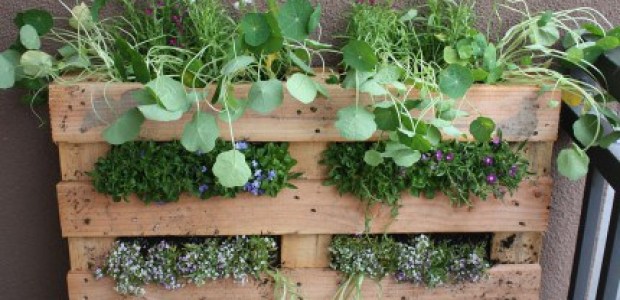You need zero square feet to grow food.
I frequently nag friends, family, and strangers to start gardening. “I’d love to have a garden, but I don’t have a yard” is by far the most common excuse I hear. No more! Here are some of my favorite DIY designs for growing food that require not even an inch of lawn. With a bit of ingenuity and elbow grease, you can even move them between apartments.
Self-Irrigating Planters
With a water chamber below the plants, sub-irrigated planters (SIPs) allow gardeners to fill their water reservoir once every week, rather than having to water their plants every day. One of the most popular commercial versions is the Earthbox, and their instruction manual (PDF) contains useful planting advice. At a fifth of the cost, you can utilize a 5-gallon bucket to get the same results with Dearthbox:

As you scale up your SIPs, Earthtainer provides in-depth instructions (PDF) for creating a larger-scale setup that’s particularly tomato-friendly:

In addition to looking great, this system provides for a larger reservoir that can be shared among multiple SIPs:

Vertical Pockets
A pocket made out of semi-porous material is a good home for a plant: water and air can reach the roots. Add some waterproof fabric as a shell and you’ve got an indoor-friendly, wall-mounted home for a variety of smaller edibles. This can be as simple as a repurposed shoe organizer:

For a more industrial aesthetic, pallets are plentiful and free:

Love the look of Wo0lly Buddy garden pockets, but uncomfortable with the price? These DIY pockets look at least as good:

Sprouts
In a hotel or some other extremely temporary situation? Seeds become delicious, nutritious sprouts in as little as two days. Mung bean seeds, water, and a container with holes are all you need for a basic system:

Here’s a cheatsheet to sprouting a variety of edibles (PDF).
Get Growing!
Producing even a salad’s worth of your own food is an incredibly rewarding experience. Once you get started, you may quickly find yourself contemplating milling your own grains and capturing rainwater. It’s a slippery slope to sustainable urban farming, and baby steps are easy to take. Why not get started today?
ADVERTISEMENT






